It’s a beautiful summer day and you’ve just mowed your lawn. The smell of freshly cut grass on that beautiful manicured lawn makes you think all is well with the world and lush grass makes your home look inviting. All thanks to your trusty lawn mower. But have you ever wondered how the lawn mower came into being?
The history of the lawn mower starts with an Englishman.
Edwin Budding decided we needed something less smelly than the sheep, which were being used to keep the grass height low on country estates, and something less labor intensive than the scythe. So, he invented the first walk behind push lawn mower.
Later, technology was developed for cutting grass that used horse-drawn lawn mowers and then steam-powered mowers. After that, lawn mower design really changed.
Let’s take a look at how the lawn mower first started and how it eventually morphed into the trusty garden tool we use today.
Table of Contents
- Before lawn mowers existed the grass still grew
- 1830 Saw the introduction of the first first lawn mower
- By 1832 the lawn mower was hugely popular
- 1868 Ushered in a new era of international mowing & major design improvements
- In 1914 we saw the introduction of the first gas-powered lawn mower
- Modern lawn mowers have changed a lot from their humble beginnings
- Even more mower developments to come!
Before lawn mowers existed the grass still grew
Before lawn mowers were invented there were still people, especially the very wealthy, who wanted nice manicured lawns that didn’t have unruly grass.
So what did they use to keep their lawns in order and the grass height low?
Well, back before lawn mowers existed there were two common methods for keeping grass low.
What were these methods?
Well cutting grass without a lawn mower wasn’t a problem in days gone by with these 2 handy methods:
- Animals
- The Scythe
Before the lawn mower, animals were used to maintain grass height on lawns
Animals that feed on grass are a great way to keep grass levels low.
However, not all vegetation eating animals are a great choice for lawn management. For instance a cow may like to much on grass but its so heavy that it leaves huge hoof prints in the ground – not to mention leaving other, smelly, deposits.
So for hundreds of years sheep and goats were used to keep grass levels low.
This is such an effective way of “cutting” your grass that it is making a huge come-back in Europe where they are using sheep instead of lawn mowers in public-owned urban areas to help combat global warming.
This ideas has proved so popular and effective that California has started doing it.
The Scythe was a labor-intensive alternative to sheep
By far the most common, and efficient, way to cut grass before the invention of the lawn mower was the Scythe.
This agriculture tool was invented in the 15th as a means to reap crops and cut grass.
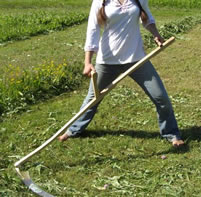 Using this tool has been traditionally called “mowing”, so that should clearly show just how effective it is as a “lawn mower”.
Using this tool has been traditionally called “mowing”, so that should clearly show just how effective it is as a “lawn mower”.
These days most people refer to its usage as “scything” rather than “mowing” purely to differentiate its use from that of a modern lawn mower.
Scything is not only a very effective way to mow your lawn but it is also fun and will help keep you fit.
1830 Saw the introduction of the first first lawn mower
Although there were horse-drawn lawn mowers that existed before the modern mechanical mower the very first lawn mower invented was actually a push mower.
This first lawn mower was invented by an Englishman called Edwin Budding back in 1830.
Edwin Budding was a engineer who came from a small village called Eastington which is situated in the county of Gloucestershire in England, UK.
Budding first introduced his new gardening invention as a method for cutting grass on golf course grounds and other sporting arenas.
He also marketed it towards the wealthy members of English society as a method for keeping their lawns in tip-top condition.
Budding was was granted a British patent on August 31, 1830 for his new reel lawn mower.
Budding’s mower was designed primarily to cut the grass on sports grounds and private and public gardens and as a superior alternative to the scythe, and the use of animals such as sheep.
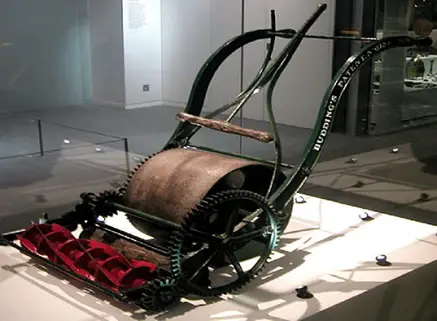
The first lawn mower’s reel design was revolutionary
Budding’s lawn mower design was an early forerunner of the modern reel mower. It was a cylinder (reel) design mower with fixed cutting blades/knives in front of the rear roller and had wheel-driven rotary blades.
His new lawn mower machine measured 19″ wide and its frames was made from wrought iron with cast iron gear wheels. This made it quite heavy and difficult to push compared to modern reel mowers and self-propelled machines. However, if was innovative and a much better, and cheaper, alternative to using a scythe which required the hiring of a labor force.
This was the very first push mower. As you pushed the mower the power was transmitted from the rear roller to the cutting cylinder. Thus the rear roller would drive the cutting knives on the cutting cylinder.
Ingenuously, Budding also ensured that the cut height could be changed via another roller that was placed between the cutting cylinder and the main roller. This could be raised or lowered to alter the height of the cut.
As the mower cut the grass the clippings would be propelled forward into a tray for later disposal.
As the lawn mower became more popular and was “field tested” it became obvious that an extra handle should be introduced at the front to help pull the machine along (see Victorian photo below).
If you visit a lawn mower museum you will be surprised at just how similar early lawn mowers are to their modern counterparts.
Where the idea for the lawn mower originated
Budding was an engineer with a great imagination. The lawn mower was not his only invention but it was by far his most successful.
He first had the idea of the lawn mower after he had seen a machine in a local cloth mill.
The machine used a cutting cylinder with a bladed reel that was mounted on a bench. The machine was used to trim the irregular nap from the surface of woollen cloth in order to give it a smooth finish.
Budding seen the potential for using this same technology to cut grass and the rest, as they say, is history.
By 1832 the lawn mower was hugely popular
Only two years after Budding first introduced his new lawn mower to the world, Ransomes of Ipswich were selling his machines.
Ransomes of Ipswich advertised the new machine in the following way:
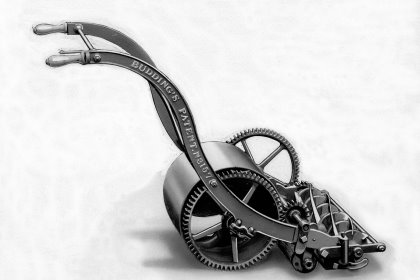
“The machine is so easy to manage, that persons unpracticed in the art of Mowing, may cut the Grass on Lawns, and Bowling Greens with ease.”
Note that the use of the word “Mowing” refers to scything as discussed above.
The instructions Ransomes of Ipswich gave for using the new machine were equally as simple:
“…take hold of the handles, as in driving a barrow[wheelbarrow], push the machine steadily forward along the greensward, without lifting the handles, but rather exerting a moderate pressure downwards…”
Imitation is the sincerest form of flattery
The lawn mower proved so popular that other inventors and companies worked to develop the idea further.
However, Budding’s design is so good that very little development has actual taken place on the human-powered lawn mower and his design is still in use today with modern reel mowers.
It did take about 10 years after the lawn mower was first sold however to create one that could be hitched to animals.
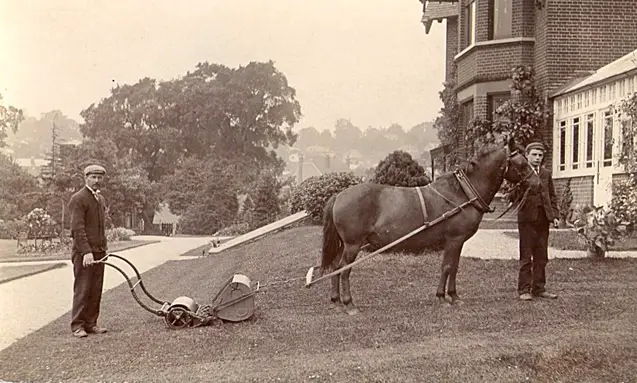
Above is a photo of a push lawn mower with front lever connected to a horse.
The horse would help pull the lawn mower as the lawn mower operator pushed and guided it from behind.
Below is a picture of the Champion horse drawn lawn mower that was presented at an 1878 Paris Exposition and a modern restored champion being used.
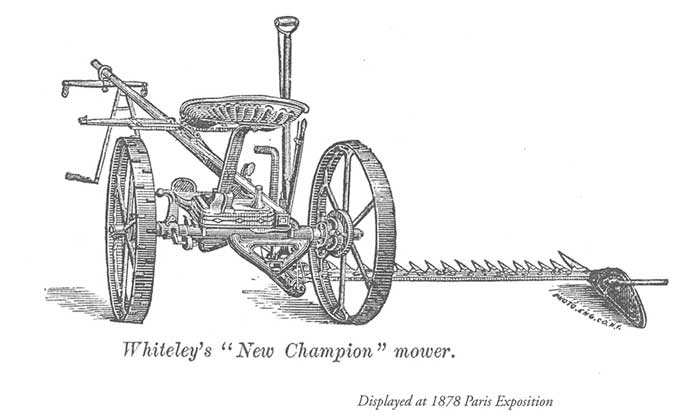
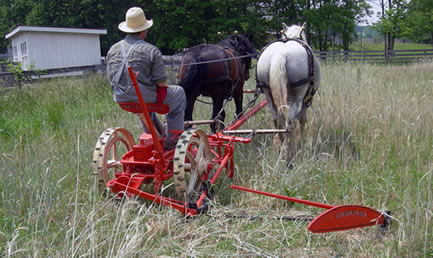
It was a further sixty years after the first lawn mower went on the market that the first steam-powered lawn mower was introduced.
1868 Ushered in a new era of international mowing & major design improvements
In the USA the very first patent for a lawn mower was granted on January 12, 1868 to Amariah Hills for a simple reel mower. Amariah Hills went on to found the Archimedean Lawn Mower Co. in 1871.
Elwood McGuire from Richmond, Indiana designed a push lawn mower in 1870, which was the first lightweight machine. It went on to become a fairly big commercial success.
Later in 1899 John Burr improved the rotary blade design that included a wheel placement for better performance.
In 1914 we saw the introduction of the first gas-powered lawn mower
It took a long time before the modern gas-powered lawn mower we see today was first introduced.
In the USA the first gas-powered lawn mowers were first introduced in 1914 by Ideal Power Mower Co. These lawn mowers were based on a patent by Ransom E. Olds who was also a pioneer of the assembly line (before Henry Ford) and the automotive industry.
You can read more about Ransom E. Old’s fascinating story here.
Modern lawn mowers have changed a lot from their humble beginnings
Now we get to the modern lawn mower.
As already discussed the modern reel or cylinder mower is almost unchanged in its design from the first reel mower invented by Edwin Buddings in 1830.
But of course we now have lawn tractors and zero turn mowers that can do things that Buddings could only dream of.
From a walk behind push reel mower to the powerful zero turn
Just as the first reel mower was an innovation that changed lawn care forever so too was the impact of the first zero turn lawn mower.
Back in 1949 Max Swisher from Warrensberg, MO, invented a machine that was to revolutionize lawn care forever.
Swisher designed and manufactured the Ride King. The very first commercially available zero turn lawn mower.
A zero turn lawn can turn on a dime; it literally can turn in its own footprint to give a mower much more control while mowing.
The Road King was a 3 wheeled mower with 1 wheel in front and 2 in the rear.
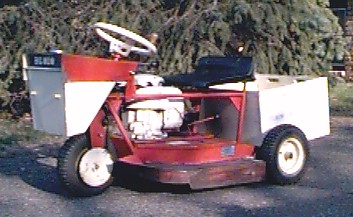
Because the system used the front wheel for steering it was able to turn a full 360 degrees in its own footprint – something that was completely new at the time.
The wheel was driven by the motor in the same direction all the time.
In order to reverse and utilize the zero turn capability you simply had to turn the steering wheel 180 degrees and the mower would move in reverse.
Later in 1963 an employee of the Hesston Corporation, which manufactured agricultural equipment, had an insight. The company had created a device called the swather. This device was propelled by a series of belts and was used to cut hay.
John Regier saw in this new device an unique opportunity. He could clearly see that this very same technology could be used in lawn mowers.
With this technology Reiger created a truly zero-turn capable lawn mower.
Unfortunately for Reiger his invention never really grab the public attention until it was sold so Hustler Turf. Hustler Turf then manufactured and sold the “Hustler” which went on to become a huge commercial success.
Then in 1969, Grasshopper Mowers introduced the first truly commercial zero-turn mower and the design was cemented into popular use after that.
Fast forward to 1974 and Dixon were the first to coin the term “zero turn radius” when they introduced their zero turn mower to the market.
Even more mower developments to come!
Of course there have been other developments and innovations since then but what we’ve covered so far basically shows the history of the lawn mower as we know it.
So the next time you start up your trusted old lawn mower give a thought to the many people who helped design and develop a now tried-and-trusted garden tool. Be thankful for this handy lawn machine that has helped shape the nation’s gardens for almost 200 years.
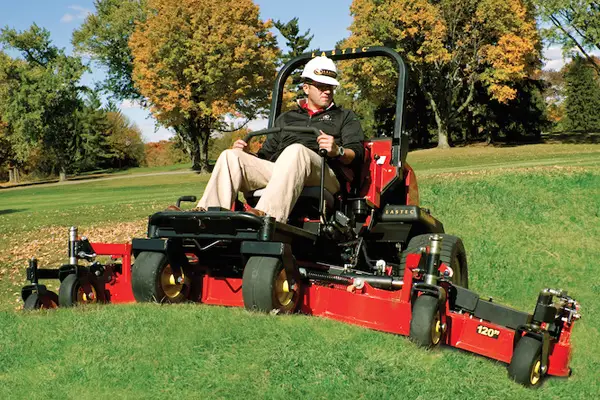
As design improvements seem to be a yearly thing these days, who knows what lies in the future of the humble lawn mower.
